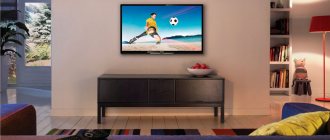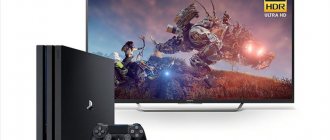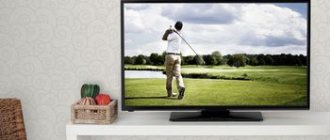Capsule coffee Nescafe Dolce Gusto Cafe O Le Coffee with milk, 3 packs of 16 capsules
1305 ₽ More details
Coffee capsules Nescafe Dolce Gusto Café Au Lait, 16 pcs.
435 ₽ More details
Processors
One of the TV parameters is the screen diagonal. The manufacturer indicates the size in centimeters and inches. Not every buyer understands what this parameter displays and what screen size is most suitable for a particular room. To make the right choice, you need to understand the concepts of “TV diagonal”, learn how to convert centimeters to inches and determine the distance from the screen to the viewer for comfortable viewing.
How to convert inches to centimeters
The inch is a non-metric system, while centimeters are a metric system and are used to measure lengths. Inches are considered an outdated system, but they are still used in technology. A double stroke is used to indicate an inch.
To make choosing a TV easier, just convert inches to centimeters. One inch is equal to 2.54 centimeters. Accordingly, a 10-inch screen will be equal to 25.4 centimeters.
To make the translation easier, you can use a table or an online calculator.
Inches (inches), designation
Part of the world measures dimensions in inches and feet. In fact, meters, centimeters, and millimeters are usually used, too, but inches are more common. These are the units of measurement in the USA, Canada, and Great Britain. And the rest follow them. It so happened, for example, that the diagonals of televisions, screen sizes in smartphones, pipe diameters, shoe sizes (and much more) are indicated in inches. So you have to think about how to convert inches to centimeters, meters or millimeters.
Converting inches to centimeters (cm) is a simple task. You just need to remember that 1 inch is 2.54 cm
First, let's talk about how these inches are designated. In English it is inch. If there are a lot of them (inches), they write inches. In the abbreviated version, only the first two letters in are used. This appears in the text. There is also a graphic image - these are two lines at the top next to the number. For example: 3″, 5.2″. It reads 3 inches, five and two inches.
How to find out the size of your TV yourself
Manufacturers indicate the dimensions of the TV and screen in the name of the equipment, but each company has its own sequence. So, for Samsung, the diagonal is reflected by the first number after the letters, for example, the Samsung UE40F8000 model has a diagonal of 40 inches.
LG has a different marking, for example, the 32LM660T model has a diagonal of 32 inches, that is, the size is indicated in the first place. The Sony KDL-42W653A model has a diagonal of 42 inches, that is, like Samsung, the size is indicated by the first digit. Similarly, the screen size in inches is displayed in the names of models from other manufacturers. If difficulties arise, you can use a search engine to find a model on the Internet and understand its size based on its characteristics.
If the model name is not known to the owner, you can find out the size yourself. To do this, use a tape measure to measure the distance from the lower left corner to the upper right corner.
Important: it is the screen size that is measured, without taking into account the frame. Otherwise the size will be incorrect.
The best 4K TVs 50 inches
Sony KD-49XH8096
This model runs on Android TV.
Its Triluminos Display technology produces beautiful 4K video with realistic, contrasting colors. Dynamic scenes are smooth and clear. Smartphones and other gadgets are connected to the TV through installed applications. The Internet works through the LAN port or Wi-Fi module. Two 10W speakers produce good sound throughout the room.
Pros:
- voice control;
- quick response to the remote control;
- narrow frame;
- automatic volume equalization.
Cons: inconvenient remote control.
LG 50UN80006
4K TV with innovative Direct LED backlighting.
External devices are connected via HDMI, of which the model has 4, and also has 2 USB ports. Voice control and integration with the Smart Home system makes the LG 50UN80006 very functional. The operating system works clearly and quickly. The display produces a detailed, contrasting image without distortion when changing the viewing angle. The price of this equipment is more than adequate.
Pros:
- built-in power supply;
- 2 antenna outputs;
- good sound;
- Magic Remote included.
Cons: no subwoofer.
Samsung UE50TU7097U
The peculiarity of this model is its thin body.
The image is clear and highly detailed. The tuner connects to TV broadcasting without spending money on a set-top box, and Wi-Fi and Smart TV provide full access to the Internet. The sound is powerful and multifaceted, the Dolby Digital Plus system produces both bass and high notes. The Live Stream function, when accessing the Internet, connects the TV to a smartphone located anywhere in the world.
Pros:
- HDR support;
- automatic settings and image scaling;
- gamer mode;
- deep black color.
Cons: not the most convenient remote control without voice control.
Philips 50PUS8505
A stylish model with an unusual design, the processor of which produces content with original quality.
The image is bright, deep, with natural color reproduction. HDR content is reproduced with maximum realism. Backlighting visually enlarges the screen, transferring colors to the wall behind it. A huge selection of interfaces, as well as Wi-Fi and Bluetooth modules, allows you to connect any external equipment.
Pros:
- Android TV OS;
- voice control;
- lighting support;
- articulated stand.
Cons: small buttons on the remote control.
Sony KD-49XH8005
The frameless LED TV with voice control runs on Android.
Even in dynamic scenes, image clarity is not lost, so the model can be used by gamers or football fans. All connected devices are controlled from one remote control. The image is clearly visible from different angles and is not distorted. A powerful processor will automatically upscale content of any resolution to 4K.
Pros:
- excellent image quality;
- fast response;
- simple settings;
- economical energy consumption.
Cons: “flat” sound.
Dimensions of TV diagonals in inches and centimeters
To easily convert inches to centimeters, you can use a ready-made table.
| Diagonal | Diagonal | ||
| inches | cm | inches | cm |
| 19 | 48 | 85 | 215,9 |
| 20 | 50,8 | 86 | 218,44 |
| 21 | 53,34 | 87 | 220,98 |
| 22 | 55,88 | 88 | 223,52 |
| 23 | 58,42 | 89 | 226,06 |
| 24 | 60,96 | 90 | 228,6 |
| 25 | 63,5 | 91 | 231,14 |
| 26 | 66,04 | 92 | 233,68 |
| 27 | 68,58 | 93 | 236,22 |
| 28 | 71,12 | 94 | 238,76 |
| 29 | 73,66 | 95 | 241,3 |
| 30 | 76,2 | 96 | 243,84 |
| 31 | 78,74 | 97 | 246,38 |
| 32 | 81,28 | 98 | 248,92 |
| 33 | 83,82 | 99 | 251,46 |
| 34 | 86,36 | 100 | 254 |
| 35 | 88,9 | 101 | 256,54 |
| 36 | 91,44 | 102 | 259,08 |
| 37 | 93,98 | 103 | 261,62 |
| 38 | 96,52 | 104 | 264,16 |
| 39 | 99,06 | 105 | 266,7 |
| 40 | 101,6 | 106 | 269,24 |
| 41 | 104,14 | 107 | 271,78 |
| 42 | 106,68 | 108 | 274,32 |
| 43 | 109,22 | 109 | 276,86 |
| 44 | 111,76 | 110 | 279,4 |
| 45 | 114,3 | 111 | 281,94 |
| 46 | 116,84 | 112 | 284,48 |
| 47 | 119,38 | 113 | 287,02 |
| 48 | 121,92 | 114 | 289,56 |
| 49 | 124,46 | 115 | 292,1 |
| 50 | 127 | 116 | 294,64 |
| 51 | 129,54 | 117 | 297,18 |
| 52 | 132,08 | 118 | 299,72 |
| 53 | 134,62 | 119 | 302,26 |
| 54 | 137,16 | 120 | 304,8 |
| 55 | 139,7 | 121 | 307,34 |
| 56 | 142,24 | 122 | 309,88 |
| 57 | 144,78 | 123 | 312,42 |
| 58 | 147,32 | 124 | 314,96 |
| 59 | 149,86 | 125 | 317,5 |
| 60 | 152,4 | 126 | 320,04 |
| 61 | 154,94 | 127 | 322,58 |
| 62 | 157,48 | 128 | 325,12 |
| 63 | 160,02 | 129 | 327,66 |
| 64 | 162,56 | 130 | 330,2 |
| 65 | 165,1 | 131 | 332,74 |
| 66 | 167,64 | 132 | 335,28 |
| 67 | 170,18 | 133 | 337,82 |
| 68 | 172,72 | 134 | 340,36 |
| 69 | 175,26 | 135 | 342,9 |
| 70 | 177,8 | 136 | 345,44 |
| 71 | 180,34 | 137 | 347,98 |
| 72 | 182,88 | 138 | 350,52 |
| 73 | 185,42 | 139 | 353,06 |
| 74 | 187,96 | 140 | 355,6 |
| 75 | 190,5 | 141 | 358,14 |
| 76 | 193,04 | 142 | 360,68 |
| 77 | 195,58 | 143 | 363,22 |
| 78 | 198,12 | 144 | 365,76 |
| 79 | 200,66 | 145 | 368,3 |
| 80 | 203,2 | 146 | 370,84 |
| 81 | 205,74 | 147 | 373,38 |
| 82 | 208,28 | 148 | 375,92 |
| 83 | 210,82 | 149 | 378,46 |
| 84 | 213,36 | 150 | 381 |
Table of TV sizes by width and height
Another important screen parameter is width and height. Moreover, even models with the same diagonal may have different parameters. This is explained by the fact that TV models have different aspect ratios. Old TVs had a 3x4 aspect ratio. Today this option is no longer used. Modern standard 16x9 and 21x9. The second option has a larger width; such screens are low, but wider. To determine the width, you can also use a table taking into account the aspect ratio.
| 16:9 | ||||
| diagonal inches | width cm | height cm | width inches | height inches |
| 19 | 42 | 23.6 | 16.56 | 9.31 |
| 22 | 48.7 | 27.4 | 19.17 | 10.79 |
| 23 | 50.9 | 28.6 | 20.05 | 11.28 |
| 24 | 53.1 | 29.9 | 20.92 | 11.77 |
| 25 | 55.3 | 31.1 | 21.79 | 12.26 |
| 26 | 57.6 | 32.4 | 22.66 | 12.75 |
| 27 | 59.8 | 33.6 | 23.53 | 13.24 |
| 28 | 62.0 | 34.9 | 43579 | 13.73 |
| 29 | 64.20 | 36.11 | 25.28 | 14.22 |
| 30 | 66.4 | 37.4 | 26.15 | 14.71 |
| 31 | 68.6 | 38.6 | 27.02 | 15.2 |
| 32 | 71 | 39.9 | 27.89 | 15.69 |
| 34 | 75.3 | 42.3 | 29.63 | 16.67 |
| 35 | 77.5 | 43.6 | 30.51 | 17.16 |
| 36 | 79.7 | 44.8 | 31.38 | 17.65 |
| 37 | 81.9 | 46.1 | 32.25 | 18.14 |
| 38 | 84.1 | 47.3 | 33.12 | 18.63 |
| 39 | 86.34 | 47.32 | 33.99 | 19.12 |
| 40 | 88.6 | 49.8 | 34.86 | 19.61 |
| 41 | 90.8 | 51.1 | 35.73 | 20.10 |
| 42 | 93 | 52.3 | 36.61 | 20.59 |
| 43 | 95.2 | 53.5 | 37.48 | 21.08 |
| 44 | 97.4 | 54.8 | 38.35 | 21.57 |
| 45 | 99.6 | 56.0 | 39.22 | 22.06 |
| 46 | 101 | 57.3 | 40.09 | 22.55 |
| 47 | 104.05 | 58.53 | 40.96 | 23.04 |
| 49 | 108.48 | 61.02 | 42.71 | 24.02 |
| 50 | 110.7 | 62.3 | 43.58 | 24.51 |
| 55 | 121 | 68.5 | 47.94 | 26.96 |
| 60 | 132 | 74.7 | 52.29 | 29.42 |
| 65 | 143.90 | 80.94 | 56.65 | 31.87 |
| 72 | 159.39 | 89.66 | 62.75 | 35.3 |
| 75 | 166 | 93.5 | 65.37 | 36.77 |
| 77 | 170.46 | 95.89 | 67.11 | 37.75 |
| 78 | 172.68 | 97.13 | 67.98 | 38.24 |
| 79 | 174.89 | 98.38 | 68.85 | 38.73 |
| 84 | 185.96 | 104.60 | 73.21 | 41.18 |
| 85 | 188.17 | 105.85 | 74.08 | 41.67 |
| 86 | 190.39 | 107.09 | 74.96 | 42.16 |
| 90 | 199.24 | 112.07 | 78.44 | 44.12 |
| 100 | 221.38 | 124.53 | 87.16 | 49.03 |
| 105 | 232.45 | 130.75 | 91.52 | 51.48 |
| 21:9 | ||||
| diagonal inches | width cm | height cm | width inches | height inches |
| 19 | 44.4 | 19 | 17.46 | 7.48 |
| 22 | 51.4 | 22 | 20.22 | 8.67 |
| 23 | 53.7 | 23 | 21.14 | 9.06 |
| 24 | 56.0 | 24.0 | 22.06 | 9.45 |
| 25 | 58.4 | 25 | 22.98 | 9.85 |
| 26 | 60.7 | 26 | 23.90 | 10.24 |
| 27 | 63.0 | 27.0 | 24.82 | 10.64 |
| 28 | 65.4 | 28.0 | 25.74 | 11.03 |
| 29 | 67.7 | 29 | 26.66 | 11.42 |
| 30 | 70.0 | 30.0 | 27.57 | 11.82 |
| 31 | 72.4 | 31.0 | 28.49 | 12.21 |
| 32 | 74.7 | 32 | 29.41 | 12.61 |
| 34 | 79.4 | 34 | 31.25 | 13.39 |
| 35 | 81.7 | 35 | 32.17 | 13.79 |
| 36 | 84.0 | 36.0 | 33.09 | 14.18 |
| 37 | 86.4 | 37.0 | 34.01 | 14.58 |
| 38 | 88.7 | 38 | 34.93 | 14.97 |
| 39 | 91.1 | 39 | 35.85 | 15.36 |
| 40 | 93.4 | 40 | 36.77 | 15.76 |
| 41 | 95.7 | 41.0 | 37.68 | 16.15 |
| 42 | 98.1 | 42 | 38.6 | 16.54 |
| 43 | 100.4 | 43.0 | 39.52 | 16.94 |
| 44 | 102.7 | 44.0 | 40.44 | 17.33 |
| 45 | 105.1 | 45.0 | 41.36 | 17.73 |
| 46 | 107.4 | 46 | 42.28 | 18.12 |
| 47 | 109.7 | 47 | 43.2 | 18.51 |
| 49 | 114.4 | 49 | 45.04 | 19.30 |
| 50 | 116.7 | 50.0 | 45.96 | 19.70 |
| 55 | 128.4 | 55 | 50.55 | 21.67 |
| 60 | 140.1 | 60 | 55.15 | 23.64 |
| 65 | 151.8 | 65 | 59.74 | 25.60 |
| 72 | 168.09 | 66.18 | 72.04 | 28.36 |
| 75 | 175.1 | 75 | 68.94 | 29.54 |
| 77 | 179.77 | 77.04 | 70.77 | 30.33 |
| 78 | 182.1 | 78 | 71.69 | 30.73 |
| 79 | 184.4 | 79.0 | 72.61 | 31.12 |
| 84 | 196.1 | 84 | 77.21 | 33.09 |
| 85 | 198.4 | 85 | 78.13 | 33.48 |
| 86 | 200.78 | 86.05 | 79.05 | 33.88 |
| 90 | 210.1 | 90 | 82.72 | 35.45 |
| 100 | 233.5 | 100.1 | 91.91 | 39.39 |
| 105 | 245.1 | 105.1 | 96.51 | 41.36 |
Security measures
Diagonal 8 inches
Watching TV involves staying in a static position for quite a long time, which can negatively affect the condition of the spine and neck, and an incorrectly installed device will have an adverse effect on vision. To prevent this from happening, a number of important factors must be taken into account.
- At a close distance to the TV, there is an increased load on the muscles and joints due to the fact that a person is completely immersed in watching and for a long time can remain in an anatomically incorrect and uncomfortable position, which, if repeated constantly, can lead to health problems.
- Placing the television device too far away is also undesirable, as it causes excessive strain on the eyes and keeps the spine in an unnatural position. It is not advisable for children and people with vision problems to expose their eyes to any stress, especially for a long time.
- When choosing a place for a TV, you need to take care not only of the correct viewing distance, but also of installing the equipment at the correct height, which will provide an optimal viewing angle that is comfortable and safe for the viewer. The recommended viewing angle is 30-40°, which allows you to clearly see the entire screen and catch any small details without straining your eyesight.
- There are standards according to which an adult should watch TV for about 2 hours, a teenager – an hour and a half, a child – 15-20 minutes. If these standards are significantly exceeded, the appearance of health problems is inevitable.
For children, you can buy a small device from 22 to 32 inches. In this case, high expansion is not needed; the strong contrast and clarity can cause headaches and eyes for children.
As practice shows, every user can calculate the safe distance to the screen. Of course, the proposed figures are provisional. They can be used as a recommended value, and the search for the optimal distance will be carried out individually
If the TV is located on the wall, then you need to take into account at what height it is located
The introduction of innovative technologies into the production process has made it possible to reduce excessive eye strain. They will not get tired even after watching for many hours. Many people forget that the cervical vertebrae are also involved in viewing. Doctors have made several recommendations to make viewing as safe as possible for the eyes and cervical spine:
- An excessively close distance will cause increased strain on the eye muscles.
- If the TV is too far away, then this will negatively affect the spine and vision, since the viewer will have to constantly strain to see the details.
- Installing a TV requires that the user not only correctly calculate the distance, but also select the optimal height, as well as the angle of inclination.
Another security measure is limited viewing time. You should not spend more than 2-3 hours in a row looking at the screen.
Actually, all aspects that directly or indirectly affect the distance between TV and the viewer were considered. The main criterion for determining the distance is the diagonal of the device screen. There are several recommendations for calculating the optimal value. All of them were listed above.
The good thing about modern TV models is that they are often sold with multifunctional brackets. Such stands can be adjusted to select the optimal angle, distance, and position.
Be sure to take into account the technical parameters of the TV device. The screen matrix also influences the viewer's distance from the viewing point. Think of the calculation formula as an additional recommendation, not a basic rule.
Diagonals from various manufacturers
Each manufacturer determines which diagonal models to produce. The buyer can only choose from the presented range:
- Samsung produces models with diagonals from 22 to 98 inches.
- LG from 22 to 87.6.
- Philips from 19 to 70.
- Hyundai from 22 to 65.
- BBK from 19 to 75.
- Sony from 24 to 97.5.
- Panasonic from 23.6 to 65.
Other manufacturers also provide a wide range of diagonal models for both small rooms and large spaces. To determine this size in centimeters, as well as find out the width and height, just refer to the tables.
What is determined by diagonal
Monitor, 23-inch TV
You can watch programs comfortably only if the TV is installed correctly. The distance from the screen to the eyes should be 3-4 diagonals. First, it is determined how many cm or inches the distance is from one corner of the screen to the other. Then the distance to the sofa or chair is calculated. From a 55″ diagonal screen, the viewer should sit 4.2 meters away.
Distance from the sofa
Some types of high-resolution TV allow you to clearly see the picture at close range. The distance to the TV can be reduced to 2.2 meters.
The second factor for a clear picture and free viewing is the height of the monitor. Ergonomics dictates that the center of the screen should be at or below eye level within 10 degrees of the horizontal. If family members are of different heights, the TV is installed at a height of 50–70 cm from the floor. For a 139.7 cm screen, the optimal distance from the bottom edge to the floor is 55 centimeters.
Viewing angle
You need to stretch the threads from the side edges of the monitor to the center of the eyes. The optimal angle between them is 20 degrees. With a closer position, it is difficult to take in the entire screen with your gaze. Then the head will constantly turn to follow the movement of the heroes to the right and left. This will lead to rapid eye and neck fatigue.
Dimensions of TV with frame and stand
Sometimes when choosing a model, the size of the TV is indicated, not the screen. This means that the diagonal was measured from the extreme points of the frame. Accordingly, the screen will be smaller by the width of the frame. Therefore, if the specifications indicate the dimensions of the TV (height/width/depth), it should be taken into account that these are the dimensions of the equipment, and not the size of the screen. The last parameter is indicated on a separate line and is measured between opposite corners of the screen without a frame.
The size of the equipment is also affected by the presence or absence of a stand or canopy. Thus, the depth of the TV includes both the thickness of the equipment and the thickness of the mounting. The same applies to the stand legs.
Types of TV screens
Tube TVs have sunk into oblivion. Their era has come to an end. The old round picture tubes have been replaced by flat screens, distinguished by their beautiful views. From now on, manufacturers have been able to create monitors that are impressive in size. Of course, all of them are presented on the market within reason, so that it is convenient and comfortable to use them.
Buyers, in turn, happily learn information about megainches and do not spare money to purchase new large TVs in household appliance stores. But don't forget that a bigger screen doesn't mean it will be better in practice. Before you understand how to choose the right TV diagonal, it is recommended to learn about the types of devices on the market.
OLED TVs
OLED screens are based on a matrix equipped with organic diodes. When an electrical impulse is passed through, they glow. There is a phosphor on the surface of the crystal, which is responsible for coloring the light beam green, blue or red. This method makes it possible to produce screens of different shapes. There are flexible panels on the market, but this solution is used extremely rarely in the case of TVs.
pros
- the quality is high;
- image brightness reaches 100,000 cd/m2;
- viewing angles are not limited;
- Contrast and color reproduction are excellent;
- low energy consumption;
- there is no flickering, there is a minimum response time of 1000 fractions of a second;
- the picture is realistic;
- There is a large selection of sizes available, although large-sized OLED formats are rarely successful, as experience shows.
Minuses
- Blue phosphor burns out very quickly;
- the price is very high;
- not every manufacturer was able to master OLED technology.
LCD TVs
These devices operate by taking into account the sifting of the light flux. This process is called polarization. In LED models, it is formed by diodes, but in LCDs, special fluorescent lamps are responsible for the process. In general, the operating principle is no different from each other.
There are liquid crystals on the monitor glass. They contribute to the delay of light waves and their transmission. As a result, a part of the picture is formed on the screen
It is important to note that the properties of the electromagnetic field that affects the LCD coating, as well as the sifting itself, occur somewhat differently. The TV image will be different
This technology makes it possible to create wide and thin screens. Of course, it has both pros and cons. It is also important to know about them in order to understand how to choose the right TV diagonal.
pros
- electricity consumption is low;
- no flickering of the image, which tires the human eye;
- The brightness of the glow is quite sufficient. It meets indicators in the region of 170-250 cd/m2;
- the picture transmission is clear, there are no distortions;
- the choice of diagonals is very large;
- the price on the market is affordable;
- long service life.
Minuses
- lack of volume and depth of the picture;
- The response time of the matrix is quite long;
- the angles are small, the view corresponds to the range of 50-125 degrees;
- resolution is fixed.
Viewing distance
When choosing a TV, what matters is how far people will sit from the screen. Viewing comfort and the degree of eye strain depend on this. The minimum is one meter, but this is for a screen with a diagonal of 37-40 centimeters. The optimal distance is at which it is comfortable to watch TV and the picture is not distorted. This indicator depends on the type of screen, diagonal and other parameters.
The screen type is important:
- 4K is a screen with a resolution of 4 thousand pixels. Accordingly, you need to sit at a distance of 2.7-3 meters from such a screen. There is also no point in placing the TV too far away, since the human eye will then not be able to see all the subtleties of the picture with such a resolution. That is, high resolution will no longer make sense.
- It is better to sit further away from the cathode ray tube TV. What matters here is the size of the diagonal. The distance to the eyes from the screen should be five times greater than the diagonal (in centimeters).
- When using plasma TVs and LED screens, the distance is also equal to the diagonal multiplied by five.
- When watching 3D TV, the distance depends on the type of screen. For example, from a Full HD TV with a diagonal of 40 inches, 1.6 meters will be enough, and for a UHD model of the same diagonal, 0.8 m will be enough.
There are also general recommendations. So, to watch programs on a 32-inch screen, it should be installed at a distance of 1.6-2.4 meters from the eyes. For a 40-inch screen, the distance will already be 2-3 meters. You should move 2.4-3.7 meters away from a 48-inch screen. But from a 50-inch TV you will have to sit at a distance of 2.5-3.8 meters.
The next parameter is the resolution or the number of points. The more of them, the farther you can watch TV without losing quality. Accordingly, with a low resolution, TV can be watched from a closer distance. Approximate parameters are shown in the table.
| Inches | 720x576 | 1280x720 | 1920x1080 |
| 19 | 1.5-2 m | 1.13 m | 0.75 m |
| 22 | 1.7-2.4 m | 1.31 m | 0.87 m |
| 26 | 2.0-2.8 m | 1.55 m | 1.03 m |
| 32 | 2.4-3.4 m | 1.9 m | 1.27 m |
| 37 | 2.8-3.9 m | 2.2 m | 1.47 m |
| 40 | 3.0-4.2 m | 2.38 m | 1.59 m |
| 42 | 3.2-4.5 m | 2.5 m | 1.66 m |
| 46 | 3.5-4.9 m | 2.74 m | 1.82 m |
| 50 | 3.8-5.3 m | 2.97 m | 1.98 m |
| 52 | 4.0-5.5 m | 3.09 m | 2.06 m |
| 55 | 4.2-5.8 m | 3.27 m | 2.8 m |
| 58 | 4.4-6.1 m | 3.45 m | 2.3 m |
Distance from viewer to monitor
To comfortably watch TV programs with a clear image and without unnecessary strain on the eyes and neck, the TV should be installed correctly. The optimal viewing angle is 20 degrees. How much is this in cm is determined by the screen size in inches.
Distance standards
Ergonomics will help with this. The science of comfort has determined that the norm to clearly see the image is 3–4 diagonals. With this distance, the monitor is completely covered by the gaze. If you sit closer, the edges of the picture will be outside the field of view.
Modern types of televisions have high resolution, and a normal monitor clearly shows the picture at close range. It is enough to move 220 centimeters away from the 49″ screen. The only remaining problem is to cover the entire image.
Viewing distance
The middle of the monitor should be in front of the audience's eyes. To do this, the TV is installed approximately at a height of 1–1.2 meters from the floor. The screen height is determined through the diagonal, divided by 2 and subtracted from 120 cm.
Choosing between size and ease of use
Screens with large diagonals are in high demand today. Buyers in stores pay attention to image quality and vivid picture quality, but when they install a TV at home, they are often disappointed. This is explained by viewing conditions.
If you install a large TV in a small room and view it at close range, the eye simply will not catch all the pixels, that is, the picture will be incomplete. In addition, it is an increased strain on the eyes. Therefore, you should not buy large models for small rooms. For convenience, you can use a universal formula: the screen diagonal, reduced by five, will be equal to the distance to the TV. There is no point in purchasing a large screen.
Features of choice
Most buyers who are not particularly strapped for money assume that buying a TV for a spacious living space should be based on the size of the screen. The larger it is in all respects, the clearer and more real the resulting image will be.
In the living room
In fact, in order to see better, you can limit yourself to a forty-inch diagonal, but provided that it has the following characteristics:
- high resolution (therefore, for a small room you can purchase excellent models from branded manufacturers, starting from 32 inches, which provide normal visualization);
- a good frequency of picture changes, allowing you to see a smooth flow, and not jerks that are harmful to vision and perception;
- sufficiently distant from the viewer (the largest screen does not provide the desired viewing pleasure if the size of the room does not allow it to be installed at the required distance from the viewer).
Subtleties
Newfangled trends among buyers very often include the installation of a special niche for the TV. Modern flat-panel TV receivers can be hung on the wall. When carrying out repairs, a strictly limited space is left for placement.
Selecting a TV receiver
In this case, what matters is not how many inches the screen diagonal is, but the three listed parameters and the dimensions of the device. They are measured by hand, taking into account the width of the plastic rim and foot, which may vary from manufacturer to manufacturer.
What to look for when choosing a TV diagonal
When choosing a screen size, there are several factors to consider. First of all, this is the size of the room. To do this, just look at the table to see which diagonal models will suit the length of the room or the distance to the place where the viewer is sitting. Accordingly, if the distance from the wall to the sofa is no more than two meters, there is no point in buying a TV with a diagonal of more than 40 inches with an average resolution.
Based on this, we can conclude that permission is also important. The higher it is, the closer you can sit to the screen. Accordingly, you can buy a large TV for the bedroom, but with high resolution. This leaves only three main options to choose from:
- Room size.
- Screen resolution.
- Screen type.
In addition to the above, such indicators as screen contrast, data update frequency, monitor color, and input delay time are important. Accordingly, if you plan to connect a game console, then you should take models with a high refresh rate, but more affordable models with a lower resolution are suitable for the kitchen.
If you make a choice, relying only on your own taste, without taking into account the numbers, you may be disappointed in the resulting picture.
Recommendations based on specifications
The distance between the TV and the eyes is calculated correctly, taking into account several other parameters: the quality of the matrix, the declared resolution of the TV, contrast and screen formatting.
Recommended distance from floor to TV
Screen size
A common misconception when thinking about how to choose the size of a TV is that the screen diagonal size determines good visualization and there is a direct connection between them. However, even on the screens of smartphones and laptops, the image is clearer. The desired viewing angle can only be achieved by fixing a fixed distance to a relatively large screen (43 or 49 inches) or by reducing the distance to TV receivers
But in this case, even with guaranteed security, it is important to take into account the number of pixels
Distance to TV
Screen resolution
Television does not always broadcast high-quality images. In 4K you need an app and additional accessories to get quality content, otherwise the software will correct the card's shortcomings, and if you sit too close, you may see a blurry image. The same rule works when zooming in for photos. How many pixels are needed to maintain a normal image?
For everyday use and long-term viewing, manufacturers recommend choosing high-resolution TVs. It is they, even with a relatively small diagonal, that allow the viewer not to depend on the distance
With such devices, you can allow yourself to sit closer, expand the possible viewing angle, and even activate peripheral vision, which is important for a person, to the maximum extent.
Watch a useful video on this topic below.
Which TV diagonal to choose?
Televisions are installed both in the halls and in secondary rooms. In each case, you need to take into account some nuances of choice to make watching programs comfortable.
To the bedroom
In the bedroom, TV is most often viewed in a lying position. The calculation in this case is standard: diagonal multiplied by five. The average bedroom area is 18 square meters. m. For such an area, a model with a screen of up to 40 inches is sufficient, but in practice, buyers often prefer models with a diagonal of up to 30 inches. This will make watching programs as comfortable as possible even in the dark without additional lighting.
To the living room
In this room, TVs with the largest diagonal are usually installed. This will allow you to use them as a home theater. The size of the screen also depends on the area of the room and the distance to the viewer. So, if you plan to install the TV at a distance of 2.5 meters from the viewer, then the diagonal can be taken up to 60 inches. With a greater distance, the diagonal increases.
To the nursery
A children's room also rarely has a large area. In addition, the TV is used for a different purpose. More often, a music center and game consoles are connected. Accordingly, it is enough to buy a model with a small screen, but good resolution and high technical parameters. This will allow you to be close to the screen without harm to your health.
To the kitchen
Special TVs are produced for the kitchen, designed to withstand the aggressive effects of temperature, humidity and dirt, but they cost an order of magnitude more than conventional models. If you can’t buy such a model, you can take a regular TV. The optimal screen size would be 16-19 inches. If the kitchen area is more than 12 square meters, then you can purchase a model with a diagonal of up to 24 inches. The equipment is installed on the wall using a bracket.
To the office
In the office, as well as in the kitchen, the TV is often used as a background for watching programs and news, so you can limit yourself to a small model with medium resolution. If it is important for work to track news or watch programs, then it is recommended to choose a model with a high resolution but a small screen. This way it can be installed close to the viewer without reducing the level of comfort.
Thus, in order to choose the right model, it is enough to know its diagonal and room parameters, and make a choice taking into account the type of screen. At the same time, do not forget that the diagonal is measured in both inches and centimeters, and it differs from the dimensions of the equipment.
Resolution and distance to TV
It is often very difficult to choose a display and the size of a TV monitor that is suitable for a room, since it is important to take into account the resolution of the device’s screen, as well as to have information about acceptable formats. After all, it is the resolution that affects the image quality and comfort when watching TV.
The new 4K technology (another name for Ultra HD) has appeared recently, but has already become widespread among fans of watching high-quality video, 2D and 3D graphics, as well as gamers who choose a TV screen as an alternative to a desktop PC or laptop to spend time playing games.
4K surpasses the characteristics of Full HD technology, exceeding the screen resolution by 4 times compared to its predecessor. The result is more than 8 million pixels.
To demonstrate its capabilities, Ultra HD requires a screen diagonal of 40 inches or more. However, it is not advisable to install such a TV in a small room, despite the fact that the picture will remain of high quality even when watching TV at close range.
TV viewing distance refers to the distance from the display to the seats. The choice of diagonal will also be influenced by the number of spectators. Thus, first you decide on the installation location of the TV and the seat, and then measure the distance between them.
Not long ago, to determine the diagonal, a single coefficient was used for all types of TV, which was 3 or 4. The owners measured the distance from the receiver to the sofa and divided by the coefficient. But this formula can only be used for outdated TV models that supported and support standard SD resolution (720x576). As modern Full HD and Ultra HD models have taken over the market segments, the formula used for calculations has changed. This was influenced by the following factors:
- high screen resolution increased image quality, and viewers could enjoy viewing even from a close distance;
- Modern TV does not have a harmful effect on the organs of vision, therefore it is safe for humans.
These criteria became the basis for the derivation of new coefficients, with the help of which the optimal TV diagonal is derived. You only need to know the resolution of the matrix and the distance to the device:
- HD Ready – 2.3;
- Full HD – 1.56;
- Ultra HD – 0.7.











